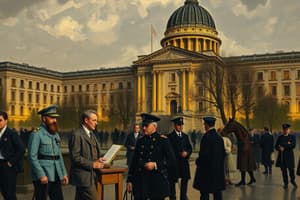Podcast
Questions and Answers
What powers did the President have during an emergency according to Article 48?
What powers did the President have during an emergency according to Article 48?
- Could appoint any chancellor without limitation
- Could only make laws with Reichstag support
- Could suspend the constitution (correct)
- Could suspend the Reichstag
How many members were in the Reichstag in 1933?
How many members were in the Reichstag in 1933?
- 421
- 500
- 750
- 647 (correct)
What was a key feature of the Treaty of Versailles regarding the German military?
What was a key feature of the Treaty of Versailles regarding the German military?
- Germany could not have any air force
- Germany was limited to 100,000 soldiers without tanks (correct)
- Germany could maintain an army of 200,000 soldiers
- Germany was allowed to develop submarines
Which of the following best defines Article 231 of the Treaty of Versailles?
Which of the following best defines Article 231 of the Treaty of Versailles?
What is NOT a question related to assessing the usefulness of a source?
What is NOT a question related to assessing the usefulness of a source?
What was George Clemenceau's primary approach towards Germany after the war?
What was George Clemenceau's primary approach towards Germany after the war?
What was a consequence of political parties using private armies in Germany between 1919 and 1922?
What was a consequence of political parties using private armies in Germany between 1919 and 1922?
Which group was involved in the Spartacist Uprising?
Which group was involved in the Spartacist Uprising?
What was a characteristic of the Freikorps in post-war Germany?
What was a characteristic of the Freikorps in post-war Germany?
What ultimately happened to the Spartacists during their uprising?
What ultimately happened to the Spartacists during their uprising?
What was a significant action taken by the Weimar government to address post-war shortages?
What was a significant action taken by the Weimar government to address post-war shortages?
What event led the Weimar government to print even more money in 1923?
What event led the Weimar government to print even more money in 1923?
Which of the following was a consequence of hyperinflation in Germany during the early 1920s?
Which of the following was a consequence of hyperinflation in Germany during the early 1920s?
What happened to people's savings due to hyperinflation during the early 1920s?
What happened to people's savings due to hyperinflation during the early 1920s?
Which uprising took place in 1923, reflecting instability within the Weimar Republic?
Which uprising took place in 1923, reflecting instability within the Weimar Republic?
What was the main reason the Freihorps rebelled during the Kapp Putsch?
What was the main reason the Freihorps rebelled during the Kapp Putsch?
What was one consequence of the passive resistance in the Ruhr?
What was one consequence of the passive resistance in the Ruhr?
Who was the leader of the Kapp Putsch?
Who was the leader of the Kapp Putsch?
What role does the President have in the German government?
What role does the President have in the German government?
What was the public sentiment regarding the Treaty of Versailles in Germany?
What was the public sentiment regarding the Treaty of Versailles in Germany?
What was the main reason for the hyperinflation crisis in Germany in 1923?
What was the main reason for the hyperinflation crisis in Germany in 1923?
Who was blamed for the economic turmoil during the hyperinflation crisis?
Who was blamed for the economic turmoil during the hyperinflation crisis?
What action did the German government take in August 1923 to address the crisis?
What action did the German government take in August 1923 to address the crisis?
What was the outcome of the Munich Putsch attempted by Hitler's Nazi party?
What was the outcome of the Munich Putsch attempted by Hitler's Nazi party?
What currency did the German government introduce to stabilize the economy after scrapping the old money?
What currency did the German government introduce to stabilize the economy after scrapping the old money?
Flashcards are hidden until you start studying
Study Notes
The Weimar Republic: A Fragile Nation
- Germany's new democratic government after WWI, faced numerous challenges.
- Article 48: Allowed the president to suspend the constitution in an emergency, bypassing the Reichstag.
- Reichstag: The parliament, with increased representation in 1933, was less powerful than the Chancellor.
- Bundesrat: This council, representing the German states, couldn't make laws but could approve those proposed by the Chancellor and Reichstag.
Treaty of Versailles & Its Impact
- Harsh conditions imposed on defeated Germany, leading to resentment and instability.
- Territorial Losses: Alsace-Lorraine returned to France, Polish Corridor created, separating Germany from East Prussia, which became a landlocked, isolated territory.
- Military Restrictions: Germany was limited to a 100,000-strong army, with no tanks, airplanes, submarines, or large battleships.
- Financial Burden: Germany was forced to pay substantial reparations (£6.6 billion) and control of Saar was handed over to France.
- Article 231 (War Guilt Clause): Germany accepted blame for the outbreak of WWI, contributing to national humiliation and fueling the "stab in the back" myth.
The "Big Three" at Versailles
- George Clemenceau: French Prime Minister, sought harsh punishment for Germany.
- David Lloyd George: British Prime Minister, favored punishing Germany but also aimed for stability in Europe.
- Woodrow Wilson: American President, championed the League of Nations, democracy, and disarmament, advocating for a peaceful settlement.
Political Violence and the Freikorps
- The post-war period saw political violence and instability.
- Private Armies: Political parties had their own armed groups, consisting of ex-soldiers disillusioned by the war.
- Freikorps: These right-wing paramilitary groups, consisting of former soldiers, fueled the "stab in the back" theory, blaming the Weimar Republic for the defeat in WWI. They played a significant role in suppressing left-wing movements.
The Spartacist Uprising
- Led by Karl Liebknecht and Rosa Luxemburg, the Spartacists aimed for a communist revolution, opposing the Weimar government.
- During the uprising, both Liebknecht and Luxemburg were killed by the military and members of the Freikorps, highlighting the severe political violence of the time.
The Kapp Putsch
- A failed attempt to overthrow the Weimar Republic by right-wing nationalist forces.
- Leader: Wolfgang Kapp, supported by the Freikorps.
- Objectives: They aimed to seize power by overthrowing the government and installing Kapp as Chancellor.
- Failure: The Putsch collapsed due to a general strike in Berlin, a significant show of opposition by workers and citizens.
Crisis 1: The Occupation of the Ruhr
- Germany's failure to meet its reparation payments prompted France and Belgium to occupy the Ruhr, a vital industrial region.
- Passive Resistance: German citizens, encouraged by the government, responded with passive resistance, refusing to work with the occupying forces.
- Economic Consequences: The passive resistance led to economic hardship in Germany, further weakening the Weimar Republic.
The Weimar Government: Structure and Powers
- President: Served as the head of state, elected every 7 years, responsible for everyday politics and the military, had the authority to choose the Chancellor.
- Chancellor: The head of government, selected a cabinet, led the Reichstag, and made critical decisions.
The "Stab in the Back" Myth
- A widespread belief among German nationalists that the German Army was not defeated militarily but was betrayed by politicians and socialists through the signing of the Armistice on November 11, 1918.
Hyperinflation: A Crisis of the Weimar Republic
- The Weimar Republic experienced devastating hyperinflation in the 1920s.
- Causes: Government printing excessive amounts of money to finance war expenses and post-war shortages, further fueled by the Ruhr occupation and the economic crisis.
- Consequences: The value of currency plummeted, savings were wiped out, and prices soared, significantly impacting the middle class, contributing to political instability and increasing support for extremist parties.
Crisis 2 of 1923: Hyperinflation
- Germany's inability to afford reparations payments after the Ruhr occupation worsened the economic crisis.
- Printing Money: To pay for workers during the passive resistance, the government printed enormous amounts of money, leading to hyperinflation.
- Devastating Impact: The value of the German Mark rapidly decreased, causing extreme economic hardship for middle-class citizens as their savings and pensions became worthless.
Crisis 3 of 1923: The Munich Putsch
- This was the Nazi Party's first attempt at a revolution, led by Adolf Hitler.
- Background: The government's decision to end passive resistance in the Ruhr fuelled anti-government sentiment among right-wing extremists, including Hitler's Nazi Party.
- The Plot: The plot aimed to overthrow the Bavarian government, with Hitler leading the charge.
- The Failure: The Putsch, a violent demonstration in Munich, was swiftly suppressed by the army and police.
4 Actions Taken By The Weimar Government
- End of Passive Resistance: The Chancellor, Gustav Stresemann, ended passive resistance in the Ruhr in September 1923, further damaging the German economy.
- Stabilizing the Currency: A new currency, the Rentenmark, was introduced in October, replacing the worthless old Mark.
- The Dawes Plan: A 1924 plan that provided a loan to Germany, enabling it to rebuild its economy and make reparation payments, helping to stabilize the country.
- Military Concessions: The Weimar government made concessions to the military to strengthen its authority and quell dissatisfaction.
Key Events Leading to the Rise of Nazi Germany (TROPICAL)
- Treaty of Versailles: Imposed harsh conditions, contributing to resentment and instability.
- Right-wing Uprisings: The Kapp Putsch demonstrated the potential for military intervention and political unrest.
- Occupation of the Ruhr: Triggered economic crisis and hyperinflation, further destabilizing the Weimar Republic.
- Proportional Representation: Created a system of government where numerous political parties had influence, leading to fragmented coalitions and difficulty in establishing a strong government.
- Article 48: This provision allowed the president to bypass the Reichstag, leading to political instability and increasing the president's power.
- Hyperinflation: The economic crisis and the worthless Mark caused widespread suffering and eroded public trust in the Weimar Republic.
- Munich Putsch: This failed attempt by the Nazi Party to seize power, while ultimately unsuccessful, demonstrated the growing strength and radicalism of the party.
- Left-wing Uprisings: The Spartacist uprising demonstrated the presence of left-wing opposition, contributing to the overall instability of the Weimar Republic.
- "November Criminals": This was a term used by nationalists and right-wing groups to discredit the Weimar Republic, claiming its leaders betrayed Germany by signing the Armistice in 1918.
Studying That Suits You
Use AI to generate personalized quizzes and flashcards to suit your learning preferences.




